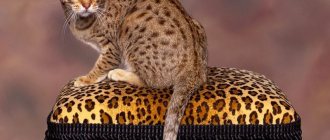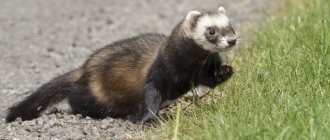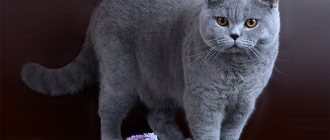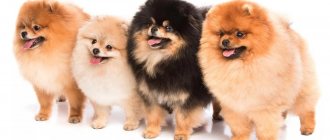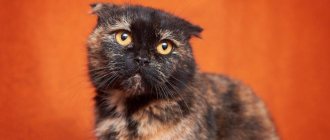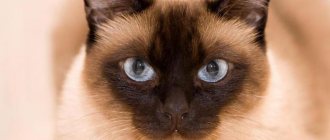Wild colors of cats: a little history
Once upon a time, wild cats lived in Europe and Africa, which did not differ in a wide variety of colors. For example, European forest cats had mostly grayish coats with the addition of ocher. The steppe cat had stripes “painted” on its fur of a sandy or grayish tint. Sometimes stripes replaced spots. That's probably all the diversity. So where did modern colors come from?
About five thousand years ago, the cat was domesticated by humans. Animals traveled around the world on ships, settled in different places, and experienced many mutations, as a result of which their color changed. Selection was of great importance. Some breeders are still working on unusual colors for pets. For example, for lovers of wild animals, cats similar to a panther or jaguar were bred. However, they have a docile nature as pets.
Genes and color
The color of a pet's fur depends on the genes that are responsible for it. And, by the way, there are not so many of them. But if there are different forms of the same gene, the color can change, have different shades and patterns. Sometimes the fur coat is so unusual and painted in such colors that it makes professional breeders and ordinary cat lovers admire.
The basic colors of pets are the basis for the rest. These include only two colors: red (red) and black. Black color appears in the presence of a special pigment called eumelanin, and red color appears in the presence of pheomelanin. The intensity of the color depends on how much melanin is contained in the hair.
Gene brighteners produce completely different colors. The brightener for black is gray (blue), for red – cream.
Cats have genes that produce white coloring with different interpretations, as well as genes responsible for patterns on the fur coat. Therefore, a bizarre pattern sometimes appears on it, ranging from ordinary stripes to mysterious curls, which are also called marble color.
A cat's coat color can be red, black, or a lightened variety of these colors, as they have an XY chromosome set. Females have a set of XX chromosomes, therefore, their color combines a greater number of shades. Therefore, the hair colors of females are more varied and bizarre. A tricolor cat is not uncommon, but it is almost impossible to find a cat of this color.
See also: How old is a cat by human standards?
There are also cats that have a black and red base color at the same time. But these are gene mutations. The set of chromosomes in such animals is XXY.
Now let's talk in more detail about the main colors.
Toyger
Thanks to its orange color with black or brown stripes and muscular body, the toyger can easily be confused with a real tiger cub. Fortunately, this breed is much nicer (and safer) to humans than a tiger cub and is known for its sweet, calm and friendly nature. The wild appearance of the Toyger was obtained by crossing a Bengal and a domestic tabby shorthair cat.
Ginger cat
Everyone loves cute saffron milk caps. No wonder they are believed to bring happiness to the house. The mere presence of a sunny cat can improve your mood. The red color is called pheomelanistic. The genes responsible for the appearance of red cats are dominant O and recessive O. In the chromosome they are combined into pairs of alleles (OO), (oo).
There are also genes on which the color intensity depends, the dominant gene (D) and the recessive gene (d). Combining with intensity genes in pairs, the genes form a bright red sunny color (ОD), or cream color (Od).
The colors of females are more varied than the colors of males, but mostly cats are red. The fact is that cats only have a set of XY chromosomes, and the color directly depends on the presence of the X chromosome. A cat becomes red only if it has two X chromosomes, each of which has a gene for red color.
Black cat
People treat black cats differently, although color does not in any way affect the character and behavior of the animals. Eumelanistic or black colors come in three types: black (B-black), brown (b-brown), light brown (bl-brown light). The strongest gene is B, and the weakest is bl. In any pair, the dominant gene predominates: Bb - the cat will be black, Bbl - also black, bbl - chocolate.
Colors also depend on the presence of intensity genes: BBDD – rich black (solid), BBDd black, BBdd blue (gray).
Gene O is stronger than gene B. So a black cat and a red cat will have red kittens.
Pixie bob
To develop a breed of cat that resembles a lynx, breeders used short-tailed forest cats. These animals live in the forests of North America. The first cat obtained in this way was named Pixie, which means “Elf” or “Fairy” in English.
The animals are distinguished by a short tail, tufts on the ears and whiskers are possible. Pixies are unpretentious, train well and easily make contact with people.
White cat
Absolutely white albino cats are extremely rare. In fact, white color has nothing to do with albinism. These are completely different things. Albinism is recessive and is designated by the “c” gene, and there are two types of albinos: those with blue eyes and those whose eyes appear red.
Now about the genes that give white color. It depends on two genes, dominant - W and recessive - w. Moreover, the gene itself does not give any color, it simply suppresses other genes, which is why the cat remains white.
When crossing two cats with WW, the offspring will have a white coat, and cats with Ww will produce offspring with pigment. Such cats are more common.
White cats are often deaf due to the fact that the deafness gene is often “stuck” to the W gene or the S gene, which is responsible for the presence of white spots. Moreover, almost half of white animals are born deaf.
Bombay
If you do not take into account the calm, patient and friendly nature of the Bombay, you might think that he is a miniature copy of the black panther. The breed's exotic appearance was achieved by crossing a sable Burmese cat with a black American Shorthair, earning it the nickname "the patent leather baby with the new penny eyes."
Tortoiseshell or calico cats
Cats that have spots of two colors all over their coats can surprise anyone with their “outfit.” After all, not all females have red genes on their two X chromosomes. Often, genes for black color are present on the second chromosome, resulting in the birth of such a spotted animal. The main tortoiseshell color is black and red, but there are other colors: blue and cream, chocolate and cinnamon.
See also: Taking care of pets: how long does estrus last in cats
Mostly females have a tortoiseshell color. In cats, this color occurs only with a set of XXY chromosomes (as a rule, such cats are sterile).
Lighting
Lighting at exhibitions often leaves much to be desired. Quite often we work under artificial lighting, fluorescent lamps, scanty daylight or the complete absence of it: after all, most exhibitions are held in sports halls, which do not even have windows. Nothing serious or sensible can be achieved under such conditions when it comes to determining or clarifying color, although from exhibition to exhibition we can observe with amazement this procedure (I don’t want to offend anyone) of “pseudo-determination” of colors. Without proper lighting, color determination simply does not make sense and any self-respecting judge should categorically refuse this work at an exhibition if it is not possible to carry out this procedure in natural daylight.
Colors of ticked cats
The so-called ticked colors are very diverse. Each fur of these animals is divided into several shades: darker turns into light, then again into dark. Ticking is the result of the action of a dominant A gene called agouti. It acts in such a way that in the first stages of wool growth the pigment is released very strongly, then decreases. Alternation occurs several times, and sections of the hair are painted in different shades. When the animal moves, its fur seems to shimmer.
Breeders are very keen on breeding cats of these colors, as they believe that this is not an easy, but very interesting task.
Savannah
A relatively new breed that was recognized by the Cat Fanciers' Association in 2012, the Savannah is known for its unusual appearance. Large, tall ears are located on the top of the head. The savanna is also characterized by a long neck, long legs and a short, thick tail. In addition, these cats have exotic spotted and striped coats. And this is not surprising, the wild appearance of the savannah was achieved by crossing the African serval with a domestic cat.
Tabby colors
Tabbies are colors with a specific pattern: circles, stripes, spots on a ticked coat. For this purpose, the T gene is required. Due to the fact that some areas of the fur coat are painted, while others are not, a pattern appears.
For example, the T gene is responsible for the brindle color. For the Abyssinian color, when there are stripes only on the face, and ticked hairs are located throughout the fur coat - Ta.
Cats' fur coats can be not only brindle, but have the most bizarre patterns.
Piebald cats
If a cat has white spots, then its color is piebald, regardless of what color the white is adjacent to. Piebaldness is evidence that the S gene is present, which is also responsible for deafness. The piebald colors themselves are very diverse. The main ones are: van, harlequin bicolor, tricolor, tuxedo.
The van (Sw gene) is considered dominant; the harlequin is recessive to it, but is dominant to the bicolor, which itself is recessive (Ss).
Van cats have a colored cap on their head and a dark tail, and the rest of their fur is white, or rather it is believed that it has such a large white spot.
Van color cat
Pets whose body is covered with colored spots on no more than a third have a color called harlequin.
Harlequin
In animals that are half colored, the color is called bicolor .
Bicolor
The piebald breed also includes the snowshoe breed, which only cats of this breed have, with white shoes and a white shirtfront.
Snow-shoe
There are animals that have very little whiteness, a small speck in the form of a medallion or button. But sometimes the spots on the fur coat are located very close and are almost invisible, so that the cat seems like just a snow queen.
Cat with a medallion spot
How to choose a spotted kitten
First, decide what kind of animal you want to get: a wild predator or a domestic cat - spotted color and exotic appearance are quite possible in both of these options. But in the first case, very large costs will be required, and not only financial: to tame a wild kitten, it will take a huge amount of time, effort, attention and patience - without a guaranteed positive result. It is quite possible that the predator will remain a predator, and its natural aggression will manifest itself at the most unexpected moment.
Yes, some cat species are more prone to domestication than others. These include, for example, the following animals:
- ocelot;
- serval;
- oncilla;
- Geoffroy's cat.
However, species identity is not an absolute guarantee that the animal will be tame. In some individuals, both animal instincts and natural distrust of humans are too strong. And then all your efforts may be in vain - you will have to get rid of the source of danger in your home. But the wild cat is not to blame for anything: he did not ask to come into your home, his place is in nature or, in extreme cases, in a zoo, where specialists will work with him.
There are very cute-looking cats that you shouldn’t even try to tame. The charming Pallas cat will remain a wayward aggressor, and the spotted baby black-footed cat will never conquer her predator instinct. And, of course, do not try to experiment with taming big wild cats: leopards, leopards and jaguars. All attempts to place them in a human apartment ended tragically - sooner or later the tiny kitten grew into a wild beast and it was no longer possible to control it...
A leopard kitten will never be completely tame.
If it’s just a question of a prestigious spotted color, opt for some safe option, specially bred for keeping in an apartment. There are many interesting domestic breeds with exotic speckled coats - they have the appearance of a wild animal and a completely docile, predictable character. But such cats are quite rare and expensive - when buying them you need to be careful not to fall into the web of scammers.
When preparing for such a purchase, carefully study the standard and features of the breed you like. If possible, involve an experienced felinologist in your selection and, together with him, examine your future baby, his parents and littermates. And, of course, do not buy a kitten from dubious sellers - only from reputable nurseries and only under an agreement with the breeder.
The spotted British kitten is a rare occurrence in a familiar breed.
Spotted kittens of domestic breeds differ from all others only in their unusual color. This version of the tabby is available in many common breeds, and a cute spotted baby can be purchased quite inexpensively. At the same time, you will have a guarantee that your pet will not have problems with education and behavior. If you want to be guaranteed to get a show-class animal, follow the same recommendations as when buying a kitten of a rare exotic breed.
Buying a kitten that is too small is always a very big risk
And one more important point. Experienced zoopsychologists advise purchasing wild cat cubs only at a very young, suckling age: a month - maximum one and a half months. Only then can the animal, through the so-called imprinting, perceive the person as its parent and accept your family as its own. In this case, there will be a chance to tame the little savage.
But this measure is forced, and the risks are very high. A kitten that is separated from its mother in such different ways can easily get sick and even die; It is very difficult to feed him correctly. If you decide to have a pet of one of the domestic breeds, then there will be no need to take risks. However, a responsible breeder will not sell you a kitten before 13 weeks of age, when it has already been vaccinated and quarantined, and its feeding schedule has been fully established.
Cats of gold and amber colors
Cats with golden coats are considered beauties, because their fur, with several tones, always seems unusual. It combines basal yellow color and ticking. The golden tones are produced by the wb or agouti genes.
Colors vary depending on the area of dyed hairs.
See also: A cat shits past the tray: what to do
If painted:
- 1/2 hair or more, the cat has a smoky-golden coat;
- 1/3 of a hair, the animal has a golden-shaded color;
- 1/8 hair, coat almost yellow, color name chinchilla golden.
In addition, there is a golden tabby, with pronounced stripes of light brown color against the ticking background.
Amber tabby
And the last very interesting color, called amber (amber). Cats of this color have modified genes. Their color is based on a modified eumelanin pigment.
Amber color
Cats with silver color
Animals with silver-colored fur are the most mysterious, if only because scientists have not yet come to an exact conclusion about the formation of silver colors. But it is known for certain that the inhibitor l gene is responsible for them.
Silver color is obtained when part of the hair is highlighted using yellow (silver) or cream (cameo) colors.
The colors are divided as follows: golden: smoky, shaded, chinchilla, tabby.
- Smoky colors are obtained when the root of the hair is white, and the hair itself is lilac, chocolate, black or blue.
Smoky color
- Shaded, when 1/3 of the hair is colored;
Silver shaded
- Chinchilla - 1/8 of the hair is dyed.
Chinchilla
- Tabby is distinguished by the presence of ticking at the ends of the hairs and a pattern on a silver background.
Silver tabby
Unlike silver, cameo has a reddish tint. The colors are formed as follows:
- 1/8 hair – cameo shell;
Cameo shell
- 1/3 – shaded cameo;
Cameo shaded
- Only the hair at the roots is not painted - cameo smoke.
Cameo smoky
- Tabby cameo is a red pattern on a pale yellow background.
cameo tabby
The order of your actions from “A” to “Z”
When determining color, as when solving any problem, it is necessary to adhere to very specific rules and recommendations and strictly observe their sequence. If, when brewing tea, you first need to warm up the kettle, then pour the tea into it and only then pour boiling water over it - it is useless to hope to enjoy delicious tea if you pour the tea into boiling water.
All the variety of colors is divided into several groups. When looking at a cat, first of all you must determine the color group or groups to which it belongs:
Self or Solid . Solid color group. Each hair is colored the same from the root to the end of the hair.
Agouti . Tabby color group. Each hair is colored with alternating darker and lighter stripes.
Tabby . Group of patterned colors. Agouti is complemented by brindle, marbled or spotted patterns.
Silver _ Group of silver colors. Only the top part of the hair is dyed. The rest of the hair is snow-white or significantly bleached.
Colourpoint or Siamese . A group of point colors, in America this color is called Himalayan. The whole body is of a fairly light tone, and all the protruding parts of the body (points) - the ears, the mask on the face, the paws and the tail - are painted in a brighter, more saturated color, which contrasts well with the main color. Although they practically don’t talk about it, the scrotum of cats is also a point.
Tortie . Group of tortoiseshell colors. Tortoiseshell colors as an independent group can be considered very conditionally. The explanation for this is simple: we are talking exclusively about females who cannot interbreed. Tortoiseshell and solid colors (group 1) are collectively called “classic colors.”
Particolours . All the above colors in combination with white. (Color groups from 1 to 6 in combination with white). Within this group there is a subgroup of bi-colors. (Colors of group 1 in combination with white). Some confusion is caused by the fact that many associations classify tortoiseshell colors as particolors, while white-colored colors are classified as bi-colors.
Note : Coat color may belong to more than one of the above color groups. This is due to the fact that genes do not influence each other in an arbitrary way, but, as a rule, only within their group, called a series, although sometimes there is a connection between genes of different series (for example, white color is associated with blue eye color and hereditary (partially) deafness; folded ears of Scottish Folds in the homozygous form are associated with skeletal deformities, etc., etc.)
Therefore, if you think that the color of a certain cat belongs to groups 2, 3 and 6, then this means that this is a tortoiseshell and you only have to determine the pattern pattern: classic? brindle? spotted? If you are in doubt about the pattern between tabby and spotted, look at the coat against the hair growth, from the tail to the head. But remember: kittens can show a mixed pattern of patterns. In this case, it is more correct to focus on a spotted pattern pattern, because The drawing tends to “tear” as it grows older.
Only after this should you try to determine the color of the coat directly. If you do not see black in the color, but only blue, then this means that you are looking at a blue patterned turtle: blue patched tabby. This is all? No, wait, just a minute more patience. Check yourself again. It is truly a tabby tortoise if the tabby pattern is equally well expressed on both a red and black background, because if you see a red tabby pattern against a solid black background, it is simply a poor example of the classic tortoiseshell pattern. And don’t forget to check the nose mirror: is it shaded? what color is the outline? Are there any signs of silver or any presence of white in the color? Especially carefully examine the chest, lower abdomen, and the feathers between the toes. Is there nothing like this? Well, then this must really be a blue patched tabby turtle.
Siamese cat colors (acromelanistic)
If a cat's ears, muzzle and tail are colored, and the rest of her coat is white, then she has an acromelanistic coloration, which is associated with temperature. The fact is that colored spots (points) appear only where the body temperature is low.
The chromosomes of Siamese or Himalayan cats contain cscs alleles, which prevent the appearance of pigment in areas where the temperature is higher.
Himalayan cat
However, color-point colors still occur when the T gene is activated. They are called lynx, lynx-point. Then a drawing appears on a white background.
Safari
One of the largest cat breeds in the world. The body length of the safari is more than a meter, the tail is thick, long and flexible. The thick plush skin requires special care. Safari is a hybrid of a domestic and wild cat.
The following breeds were used for crossing: Geoffroy, Bengals and Siamese cats. Distinctive features: leopard color, well-developed muscles, pronounced cheekbones on the muzzle, the outer corners of the eyes are noticeably raised.
